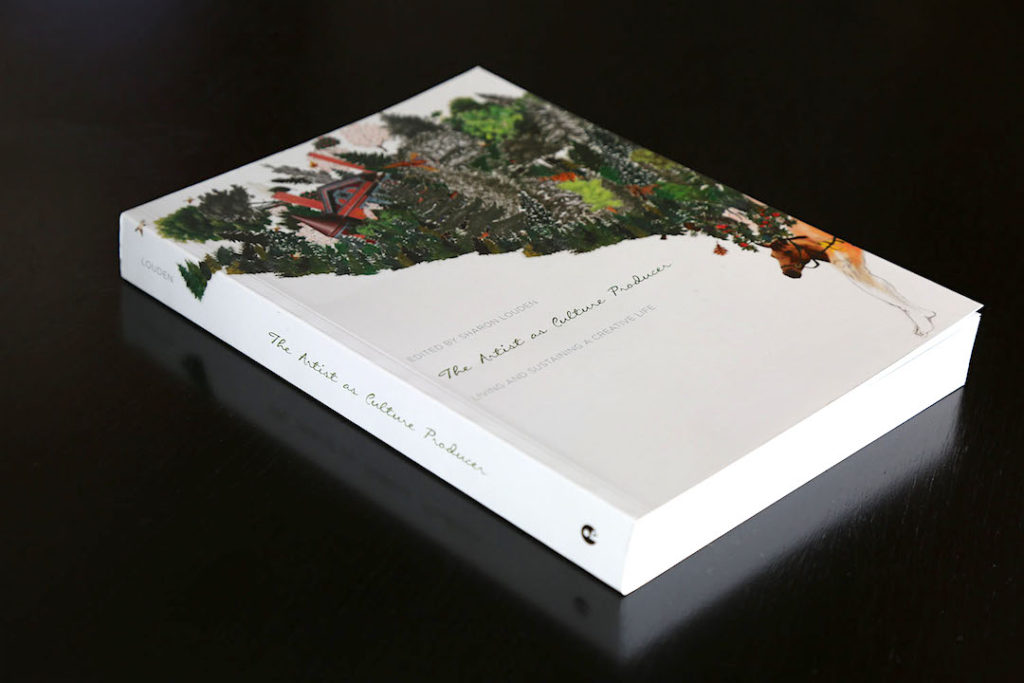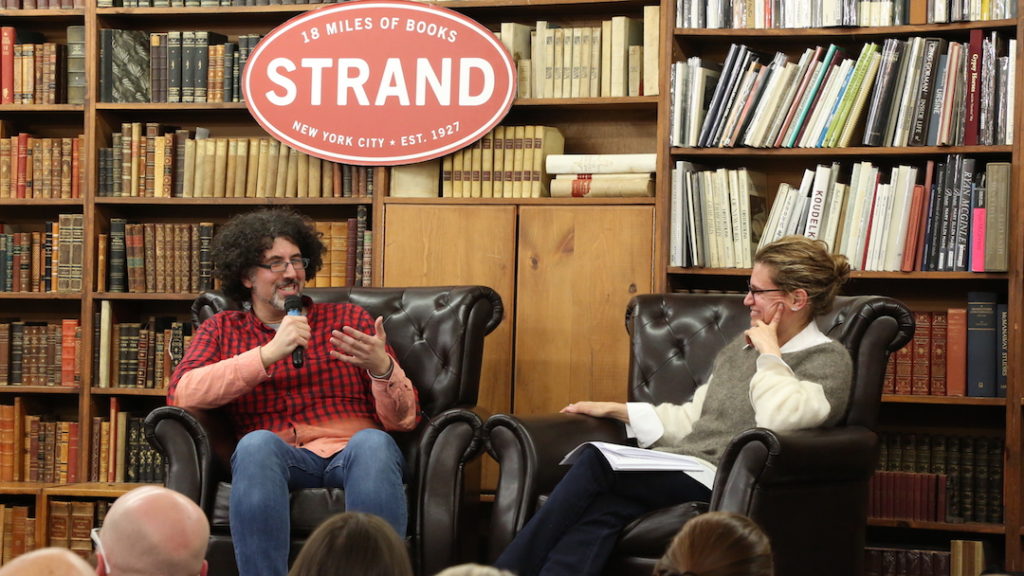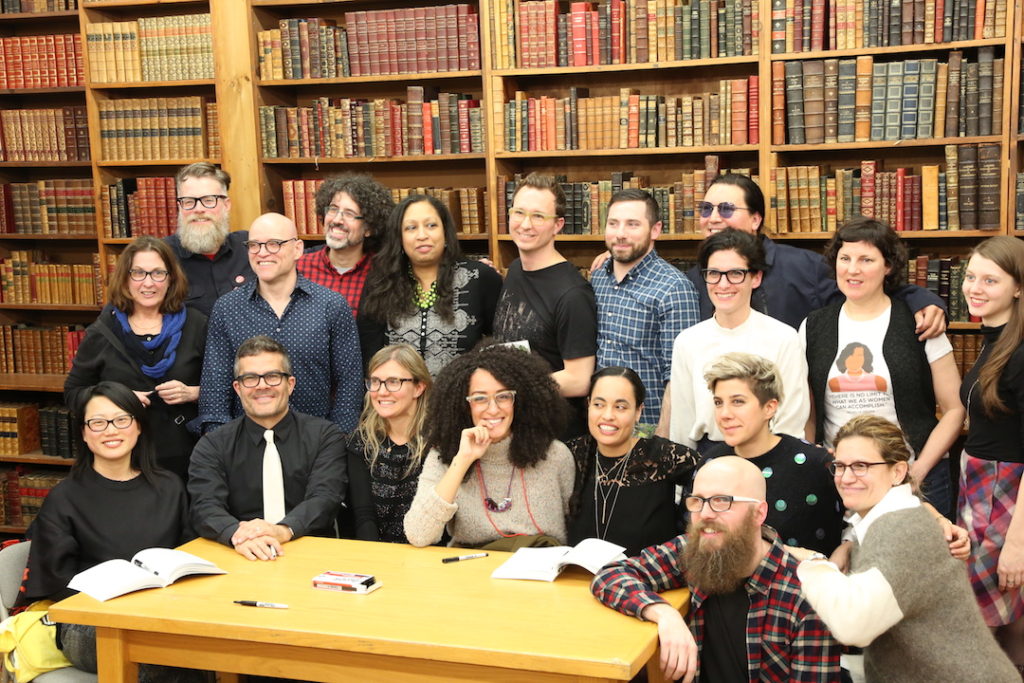
The Artist as Cultural Producer: Living and Sustaining a Creative Life, Edited by Sharon Louden, Published by Intellect Bristol, UK/Chicago, USA, 2017
Sharon Louden is generous and prides herself on connecting people, ever-expanding an extensive art network. Just having released her second book, The Artist as Culture Producer: Living and Sustaining a Creative Life, Louden has compiled a series of essays solely for the benefit of those seeking to live —and prosper— from a creative life. A woman of many facets, she is a practicing artist, author, curator, and organizes talks —two of which I’ve been part of— at the New York Academy of Art. Joining forces with the likes of Hrag Vartanian, Editor-in-Chief and Cofounder of Hyperallergic, artists Edgar Arceneaux, Shinique Smith and Andrea Zittel amongst others, she is currently on a multi-city book tour giving talks at venues ranging from museums to universities. I recently sat down with her to discuss her altruistic approach to community building, networking and spreading the message that if you want to succeed in an artistic industry, anything is possible as long as you are willing to work for it. Arriving at such a prescient time, under a Trump presidency, the book serves as a reminder that artists are not alone in their various pursuits. The tour becomes a way to move forward, instigating conversation and hopefully change.

Founding Editor of Hyperallergic Hrag Vartanian with Artist and Author Sharon Louden in a recent discussion at Strand Book Store, New York, 2017
Katy Diamond Hamer: This is the second time you’ve done a very rigorous book tour not only promoting a new release, but also delving headfirst into art communities around the US and globe (Australia) who are hungry for knowledge on how to live creatively.
Sharon Louden: On my last book tour I realized that it’s really helpful to go to communities and be direct. When you’re in person with students or members of a particular group you can reach them; movement happens quicker. There’s nothing like giving someone a hug and saying, ‘You can do this too. We’re all in it together.’ This time, with the political climate as it is, the venues [we are going to] are creating safe spaces to exchange, share, express and create. I think that’s something really special. In addition, I chose people for The Artist as Culture Producer: Living and Sustaining a Creative Life, who I know are generous and actually make opportunities happen for others, So their models can be replicated by other artists and they can foster conversation that can be meaningful but also impactful. This can help not only reinforce empowerment but offer a realization that regarding finances —it is possible to sustain a creative life. I chose Hrag [Vartanian] to be the quarterback of this book as well as write the forward, because he is a thought-leader, an entrepreneur and —unknown fact— a behind-the-scenes a photographer.
I don’t think there is anything romantic about being an artist or living a creative life.
Katy Diamond Hamer: With this most recent book, you hope to create a bridge between the artist as cultural producer and the society at large. Can you say more about this as a philosophy?
SL: All of the contributors are practicing artists and socially engaged. Alex Soth lives in Minneapolis and has a publishing business where he publishes photographs and books in collaboration with other local artists. Not many people know about it. Edgar Arceneaux, who started the not-for-profit organization Watts House Project* with the goal of unifying and beautifying the Watts neighborhood. The Dufala brothers, Billy and Steven, started a residency in Philadelphia with the department of sanitation that is based on using trash. They also rent out studios. Lenka Clayton started an online residency for mothers and those in the throes of motherhood. They can all do this from their respective studios, beyond their own practices engaging with the community and expanding networks.
KDH: Do any of these activities lend themselves to being lucrative inside or outside their own art practice?
SL: I think it’s both. I don’t think anyone is getting rich but I think it’s a mix of those who are profiting, it becomes the center-point for other opportunities. Steve Lambert has his own not-for-profit and he teaches but I think they are cross referenced. Brett Wallace is in this book, he works at LinkedIn and they hired him partially because he’s an artist. I love the idea of the artist functioning within the corporate sector. It just reiterates that there are ways artists are being embraced and that hopefully this can be an example for other corporations. I don’t think that there are many artists who sustain themselves only from their sales. The artists in the book have been able to find ways to diversify their careers and make it work. None of these essays give advise.
KDH: Did you personally know all the contributors prior to reaching out?
SL: I didn’t know half of the artists in the book and strive to create community even through their participation.
KDH: What is the longest essay in the book?
SL: The longest essay is about 7,000 words and it’s by Edgar Arceneux. There is a range though because Alex Soth is 1,000 words. There is so much to say and each could say more on the topic at hand.
KDH: Can you speak candidly on the numbers of the book?
SL: I truly believe that if you have an opportunity you must share it and in this case, it’s not a money-making venture. Right now we have 88 scheduled events on the tour out of 95 stops. Every artist gets their own copyright and I split all the royalties with them as well which was how it was done in the last book also. The last book was 8% profit and this book is 10% profit. We’ve had four checks so far [since the initial publication of Living and Sustaining a Creative Life:
Essays by 40 Working Artists, 2013] one every year. We —I include myself as a contributor— received a check this year for $763 and I split that 44 ways, Our checks were $17.34 each.
This time around we made The Artist as Culture Producer: Living and Sustaining a Creative Life a creative entity. We raised $12,000 for the tour through fiscal sponsoring and asking for money which is a tax write-off. The last time we did it through Kickstarter and raised about $6500.
Last July 13th I listened to an interview on WNYC with Darren Walker at the Ford Foundation. He was talking about housing and how artists are still important and how New York needs to embrace them and keep them here [specifically due to] the rising costs of living and studio rental. It was so empowering and feeling a kindred spirit, I felt that I had to meet him. I wanted to find a way to bring his initiatives with me on this tour. I got his email address by taking someone out to lunch and cold-called it. I didn’t hear back so found his executive assistants address and got a meeting with him. After a short correspondence he said, “Not only will we endorse this project, we will give you a grant to go to marginalized communities.” So the Ford Foundation has given us money to go to Australia, Baltimore, and many other places that would never be able to host us. The venues we are going have put together an umbrella budget and are paying fees for people to speak, transportation and lodging. So all together we raised approximately $177,000. Artists can do things.
KDH: How did you go about pitching your authors?
SL: There were some people who didn’t feel comfortable talking about what we needed for the book, others were too busy. Some people I asked to participate and when their essays came in, I realized I couldn’t have them in the book. That was painful and happened in the first book too. There were some people I wanted work with, invited and then retracted after seeing a particular energy in their social media presence. I just couldn’t do it although I’m a great supporter of what they are doing, it just wasn’t the right fit.
I envision the book as if an artist is at a party and a person who is an admirer of that artist is standing behind them and taps them on the shoulder. The role of the reader is to observe, rather than being shouted at. I’m interested in people sharing their lives.

Several of the contributors along with Sharon Louden (bottom right) at Strand Book Store, New York, the first stop of the tour for “The Artist as Cultural Producer: Living and Sustaining A Creative Life,” 2017
KDH: From where I stand, I’ve witnessed groups of artists who are very communal, sharing space, ideas and constructive criticism. Yet there are others who are singular and somewhat insular, existing on their own. I guess both fit certain roles to some extent. However a huge part of a network in any industry can also be —and I don’t know if this is slated more heavily to urban environments such as New York—a cutthroat nature. Curating essays on the written page somehow avoids that, creating partnerships and camaraderie even without every meeting.
SL: We are all insecure but I am genuinely happy when someone has the opportunity to move forward. This advocacy is very important to me. At the end of the day, it’s all about love. One of the reasons we are going to Australia is that they’ve lost 70% of their arts funding in two years. There’s no art funding for individuals. There’s a disease called conservative oppression in the world, but artists should be able to continue on. We can live in the cracks and I believe we always have.
__________________________________________________________
*Editor’s note: In 2012 Arceneux stepped down as Director of Watts House Project but remains on the board. The organization raised $700,000 but has had a delay in progressing in the beautifying process. I was unable to find any press related to the project after a 2014 tweet update. In the “Artist As Culture Producer” Arceneux speaks candidly about the project and experience…an interesting update.
Katy Diamond Hamer is the Founding Editor of Eyes Towards the Dove and a freelance art writer focused on global contemporary art and culture. For more of her writing visit katyhamer.com and @katyhamer on Instagram.
